The tree of life is an archetype and motif found in cultures, mythologies and religions around the world, and has served as inspiration for craftspeople and artists for thousands of years.
The tree can represent eternal life, the mysteries of creation or a connecting link between human beings, the cosmos and the divine.
For Buddhists, Bodhi trees came to be seen as sacred for it was under one that Buddha attained enlightenment; in Islam, the Shajarat Al-Tuba or tree of bliss, is found in paradise, where its bark is used to make the clothes worn by the inhabitants; in Judaism and Christianity, the tree of life is mentioned in Genesis as the center of the Garden of Eden, where it bore fruit all year long; in China, the goddess Xi Wangmu (西王母) grew peaches of immortality on a giant tree that linked heaven and earth; to the Iban of Borneo, the tree of life is the connection between heaven and earth.
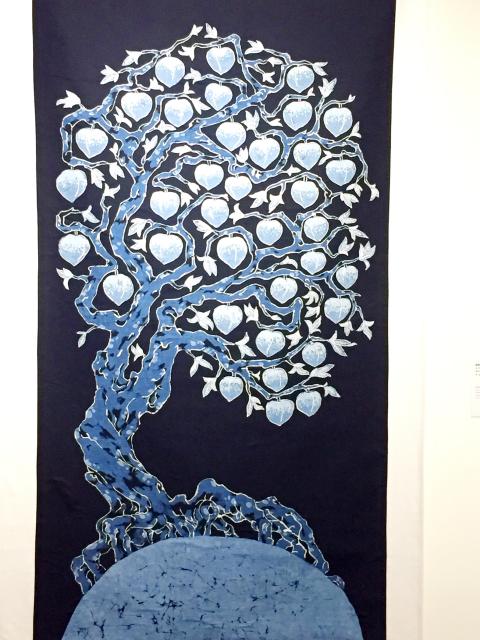
Credit: Diane Baker, Taipei Times
The image of the tree of life, or parts of it, can be found in everything from stone carvings, jewelry, carpets and leatherwork to embroidery, clothing, paintings and ceramics, in a variety of forms and shapes.
The commonality of the motif is what first inspired Malaysian architect-turned-designer Edric Ong (王良民) and Crafts Council of India vice president Manjari Nirula, who met each other through their work with the World Craft Council, to organize a Malaysia-India exhibition of traditional craft works in 2003.
It brought them together again three years ago to curate an exhibition in Kuala Lumpur of more than 200 works by craftspeople and artists from 18 nations in South, Central and Southeast Asia, centered around the tree of life.
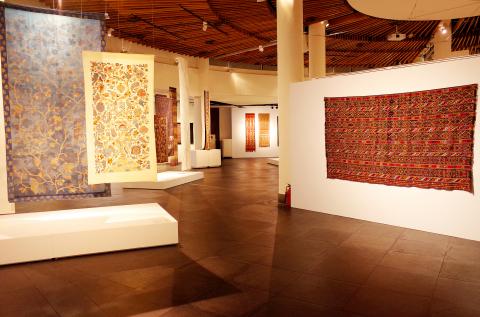
Credit: Photo courtesy of National Taiwan Craft Research and Development Institute
A smaller version of show traveled to India, followed by stops in Honolulu, Hawaii, and Vancouver, Canada. In each country, local curators were brought on to mount the show and select pieces by artists and craftspeople from their nations to be included.
The National Taiwan Craft Research and Development Institute brought the show to Taiwan, first to its headquarters in Puli, Nantou County, for four months, before moving it to Taipei, where it opened on Aug. 31 for a five-month run.
Two Taipei National University of the Arts faculty, Chen Wan-lee (陳婉麗), a professor in the theatrical design and technology department as well as a clothing designer, and Chiang Min-chin (江明親), an assistant professor at the Graduate Institute of Architecture and Cultural Heritage, served as the Taiwanese curators.
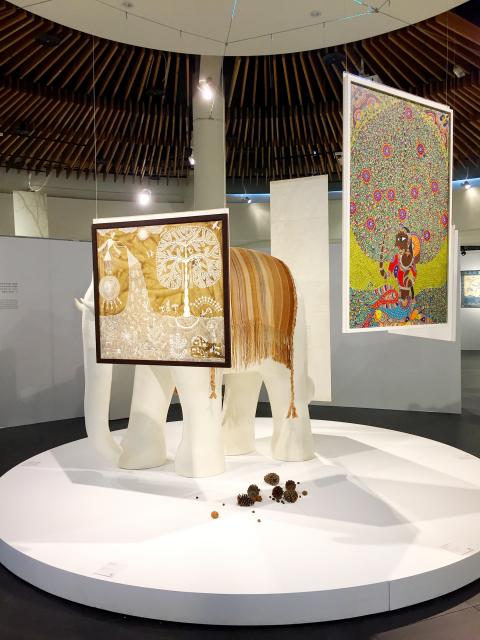
Photo: Diane Baker, Taipei Times
For Ong and Nirula, preserving traditional craftsmanship is not just about keeping old crafts alive, but of ensuring that they remain viable culturally and economically, and exhibitions such as the “Tree of Life” can help do that.
In an interview on May 5 in Puli, Nirula said that finding new markets for traditional craftspeople and artisans is crucial if these arts are to survive. The growing trend toward environmentalism and ecological sustainability is actually helping in this effort, she said.
A fashion show yesterday morning that was part of the official opening ceremony for the Taipei exhibition featured works by four designers, including Ong, promoting the exhibition’s message through the use of traditional plant dyes, fiber technology and other materials.
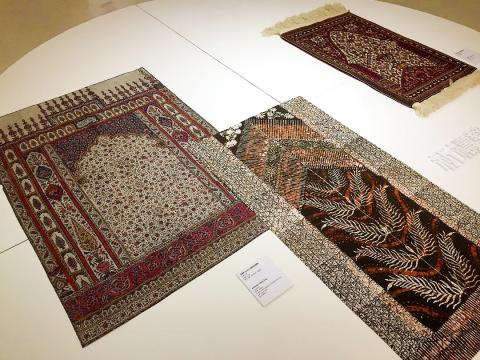
Photo: Diane Baker, Taipei Times
Ong’s outfits included handpainted designs on reworked leather jackets and woven hats based on a traditional Iban Topi Tunjang design — an example of which is in the show — while young Kyrgyz designer Yntymak Abdyldaev, who just graduated from university in May last year, uses felt, a traditional staple material of his nomadic people, as well as ancient shamanic motifs in his clothing.
Abdyldaev and Indian designer Sunita Shankar are giving talks today about their work. Shankar’s lecture, “My Journey in The Craft Sector & Working on Sustainable Fashion,” is from 10am to 12pm, while Abdyldaev’s “Searching Inspiration” is from 2pm to 4pm. Both require advance registration, links to which can be found on the institute’s Web site.
The 67 works in the Taipei version of the exhibition come in a dizzying array of materials, shapes and sizes, and include both traditional crafts and contemporary interpretations. Eight of the artists are recipients of the UNESCO-World Crafts Council Award of Excellence, which recognizes their mastery and preservation of traditional crafts.
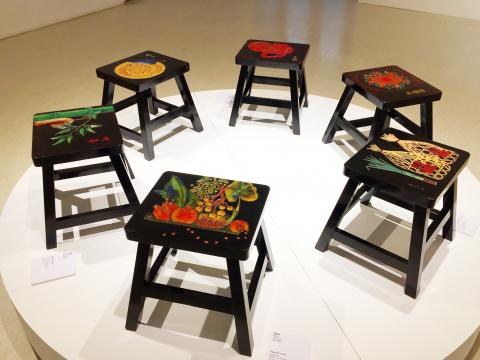
Photo: Diane Baker, Taipei Times
The works have been grouped in four sections: Being Mortal, Prayer, Fluidity and Transformation.
One of the interesting aspects of the show is that while its focus is interpretations of the tree of life from various countries and cultures, it also demonstrates the possibilities of cross-cultural pollination.
One such work is a meters-long black silk obi created by Indian artist Jai Prakash, one of the UNESCO-World Crafts Council award winners, for a Japanese client, with hand-painted scenes of deer under a tree of life.
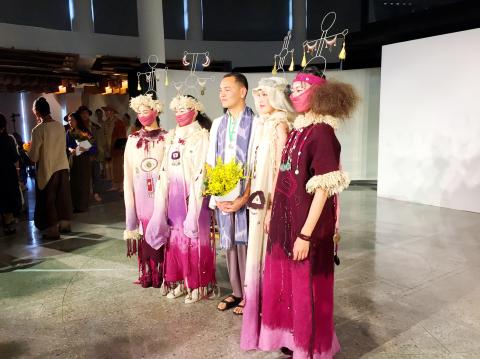
Photo: Diane Baker, Taipei Times
Prakash’s obi combines a Japanese color palate with the fine details of Indian miniaturist traditions.
A circular “yarn painting” by Mexican artist Cilau Valadez — yes, he is from outside the regional scope of the show, but there is also an antique woman’s robe from Palestine — features traditional colors and symbols of the Huichol people, but with a modern twist.
At first the circular piece appears to be needlepoint embroidery, but Valadez does not sew with yarn — he presses it into a board that has been treated with wax and resin, a Huichol traditional art form.
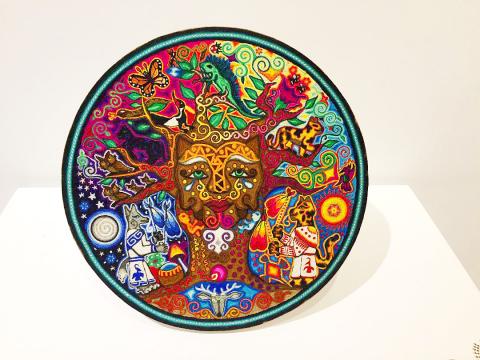
Photo: Diane Baker, Taipei Times
Tang Wen-chun’s (湯文君) Blossom in Winter is a tripartite silk wall hanging made by stencil dyeing with traditional indigo; each gossamer panel is beautiful on its own, but viewed from the front they combine into a subtly shaded blossoming tree.
The “Tree of Life” show, which runs through Jan. 27, can easily be viewed in less than an hour — but each piece is worth close inspection.
For thousands of years, the tree of life was believed to wide and tall enough to serve as connection between heaven and earth. Today the tree is serving as a bridge connecting peoples and cultures.

May 26 to June 1 When the Qing Dynasty first took control over many parts of Taiwan in 1684, it roughly continued the Kingdom of Tungning’s administrative borders (see below), setting up one prefecture and three counties. The actual area of control covered today’s Chiayi, Tainan and Kaohsiung. The administrative center was in Taiwan Prefecture, in today’s Tainan. But as Han settlement expanded and due to rebellions and other international incidents, the administrative units became more complex. By the time Taiwan became a province of the Qing in 1887, there were three prefectures, eleven counties, three subprefectures and one directly-administered prefecture, with

It’s an enormous dome of colorful glass, something between the Sistine Chapel and a Marc Chagall fresco. And yet, it’s just a subway station. Formosa Boulevard is the heart of Kaohsiung’s mass transit system. In metro terms, it’s modest: the only transfer station in a network with just two lines. But it’s a landmark nonetheless: a civic space that serves as much more than a point of transit. On a hot Sunday, the corridors and vast halls are filled with a market selling everything from second-hand clothes to toys and house decorations. It’s just one of the many events the station hosts,

Two moves show Taichung Mayor Lu Shiow-yen (盧秀燕) is gunning for Chinese Nationalist Party (KMT) party chair and the 2028 presidential election. Technically, these are not yet “officially” official, but by the rules of Taiwan politics, she is now on the dance floor. Earlier this month Lu confirmed in an interview in Japan’s Nikkei that she was considering running for KMT chair. This is not new news, but according to reports from her camp she previously was still considering the case for and against running. By choosing a respected, international news outlet, she declared it to the world. While the outside world

Through art and storytelling, La Benida Hui empowers children to become environmental heroes, using everything from SpongeBob to microorganisms to reimagine their relationship with nature. “I tell the students that they have superpowers. It needs to be emphasized that their choices can make a difference,” says Hui, an environmental artist and education specialist. For her second year as Badou Elementary’s artist in residence, Hui leads creative lessons on environmental protection, where students reflect on their relationship with nature and transform beach waste into artworks. Standing in lush green hills overlooking the ocean with land extending into the intertidal zone, the school in Keelung